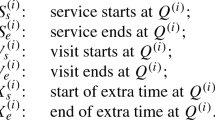Abstract
This paper analyzes a 2-class, single-server polling model operating under a \(k_i\)-limited service discipline with class-dependent switchover times. Arrivals to each class are assumed to follow a Poisson process with phase-type distributed service times. Within each queue, customers are impatient and renege (i.e., abandon the queue) if the time before entry into service exceeds an exponentially distributed patience time. We model the queueing system as a level-dependent quasi-birth-and-death process, and the steady-state joint queue length distribution as well as the per-class waiting time distributions are computed via the use of matrix analytic techniques. The impacts of reneging and choice of service time distribution are investigated through a series of numerical experiments, with a particular focus on the determination of \((k_1,k_2)\) which minimizes a cost function involving the expected time a customer spends waiting in the queue and an additional penalty cost should reneging take place.





Similar content being viewed by others
References
Boon, M. A. A. (2011). Polling models: From theory to traffic intersections. Doctoral dissertation, Eindhoven: Technische Universiteit Eindhoven.
Boon, M. A. A. (2012). A polling model with reneging at polling instants. Annals of Operations Research, 198(1), 5–23.
Boon, M. A. A., van der Mei, R. D., & Winands, E. M. M. (2011). Applications of polling systems. Surveys in Operations Research and Management Science, 16(2), 67–82.
Boon, M. A. A., van Wijk, A. C. C., Adan, I. J. B. F., & Boxma, O. J. (2010). A polling model with smart customers. Queueing Systems, 66(3), 239–274.
Boon, M. A. A., & Winands, E. M. M. (2014). Heavy-traffic analysis of \(k\)-limited polling systems. Probability in the Engineering and Informational Sciences, 28(4), 451–471.
Borst, S. C., Boxma, O. J., & Levy, H. (1995). The use of service limits for efficient operation of multistation single-medium communication systems. IEEE/ACM Transactions on Networking, 3(5), 602–612.
Bright, L., & Taylor, P. G. (1995). Calculating the equilibrium distribution in level dependent quasi-birth-and-death processes. Stochastic Models, 11(3), 497–525.
Chang, W., & Down, D. G. (2002). Exact asympototics for \(k_i\)-limited exponential polling models. Queueing Systems, 42(4), 401–419.
Gaver, D. P., Jacobs, P. A., & Latouche, G. (1984). Finite birth-and-death models in randomly changing environments. Advances in Applied Probability, 16(4), 715–731.
Graves, S. C. (1982). The application of queueing theory to continuous perishable inventory systems. Management Science, 28(4), 400–406.
Gromoll, H. C., Robert, P., Zwart, B., & Bakker, R. (2006). The impact of reneging in processor sharing queues. In Proceedings of the joint international conference on measurement and modeling of computer systems (pp. 87–96), Saint Malo, France.
Latouche, G., & Ramaswami, V. (1999). Introduction to matrix analytic methods in stochastic modeling. Philadelphia, PA: ASA SIAM.
Levy, H., & Sidi, M. (1990). Polling systems: Applications, modeling and optimization. IEEE Transactions on Communications, COM–38(10), 1750–1760.
MacPhee, I., Menshikov, M., Petritis, D., & Popov, S. (2007). A Markov chain model of a polling system with parameter regeneration. Annals of Applied Probability, 17(5/6), 1447–1473.
Mishkoy, G., Krieger, U. R., & Bejenari, D. (2012). Matrix algorithm for polling models with PH distribution. Buletinul Academiei de Ştiinţe a Republicii Moldova. Matematica, 68(1), 70–80.
Perel, E., & Yechiali, U. (2017). Two-queue polling systems with switching policy based on the queue that is not being served. Stochastic Models, 33(3), 430–450.
Takagi, H. (1988). Queueing analysis of polling models. ACM Computing Surveys, 20(1), 5–28.
Tijms, H. C. (2003). A first course in stochastic models. Chichester: Wiley.
van Vuuren, M., & Winands, E. M. M. (2007). Iterative approximation of \(k\)-limited polling systems. Queueing Systems, 55(3), 161–178.
Vishnevskii, V. M., & Semenova, O. V. (2006). Mathematical methods to study the polling systems. Automation and Remote Control, 67(2), 173–220.
Vishnevskii, V. M., & Semenova, O. V. (2008). The power-series algorithm for two-queue polling system with impatient customers. In Proceedings of ICT 2008—15th International conference on telecommunications (pp. 1–3), Saint-Petersburg, Russia.
Vishnevskii, V. M., & Semenova, O. V. (2009). The power-series algorithm for \(M/M/1\)-type polling system with impatient customers. In Proceedings of EUROCON 2009—International conference on computer as a tool (pp. 1915–1918), Saint-Petersburg, Russia.
Winands, E. M. M., Adan, I. J. B. F., van Houtum, J., & Down, D. G. (2009). A state-dependent polling model with \(k\)-limited service. Probability in the Engineering and Informational Sciences, 23(2), 385–408.
Acknowledgements
Steve Drekic and Kevin Granville thank the anonymous referee and the editor-in-chief for their supportive comments and helpful suggestions. Steve Drekic and Kevin Granville also acknowledge the financial support from the Natural Sciences and Engineering Research Council of Canada through its Discovery Grants program (#RGPIN-2016-03685) and Postgraduate Scholarship-Doctoral program, respectively.
Author information
Authors and Affiliations
Corresponding author
Ethics declarations
Conflict of interest
The authors declare no conflict of interest.
Rights and permissions
About this article
Cite this article
Granville, K., Drekic, S. On a 2-class polling model with reneging and \(k_i\)-limited service. Ann Oper Res 274, 267–290 (2019). https://doi.org/10.1007/s10479-018-2915-y
Published:
Issue Date:
DOI: https://doi.org/10.1007/s10479-018-2915-y




